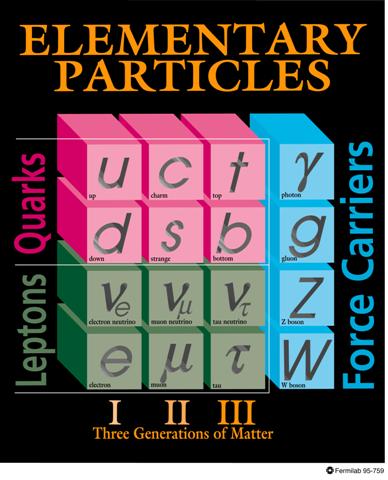Main Injector Neutrino Oscillation Search: Neutrinos
The neutrino (Italian for "little neutral one") is an elementary particle. The elementary particles, to our knowledge, are not composed of smaller particles. Neutrinos belong to the group of elementary particles known as leptons. The leptons are divided into two classes: charged and uncharged. You are likely familiar with the electron, which is a charged lepton.
 Neutrinos are uncharged leptons. Neutrinos are produced by natural radioactive decay and can be produced through particle acceleration in a laboratory setting. Neutrinos have very little mass, travel very close to the speed of light, and are able to pass through most matter without being affected. Because they travel so easily through matter it is advantageous to have the MINOS detector 2341 feet underground and 455 miles from the neutrino beam source at Fermilab. The ½ mile of rock acts as a natural filter against other particles both from natural sources as well as from the particle beam at Fermilab. It only takes the neutrino .0025 seconds to travel from Fermilab to Soudan Mine.
Neutrinos are uncharged leptons. Neutrinos are produced by natural radioactive decay and can be produced through particle acceleration in a laboratory setting. Neutrinos have very little mass, travel very close to the speed of light, and are able to pass through most matter without being affected. Because they travel so easily through matter it is advantageous to have the MINOS detector 2341 feet underground and 455 miles from the neutrino beam source at Fermilab. The ½ mile of rock acts as a natural filter against other particles both from natural sources as well as from the particle beam at Fermilab. It only takes the neutrino .0025 seconds to travel from Fermilab to Soudan Mine.
Neutrinos come in at least three different 'flavors,' that is to say three different types. The electron neutrino is paired with light electron; the muon neutrino is paired with the electron's sibling the muon, and similarly for the short-lived tau particle and tau neutrino. Quantum Mechanics (the physics of particles) predicts that neutrinos will change from one type to another, or oscillate, if they have mass. MINOS is designed to search for these oscillations. Because neutrino masses are not accounted for in the standard model of particle physics, observing neutrino oscillation is a significant step forward in understanding.


